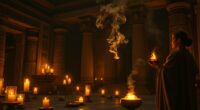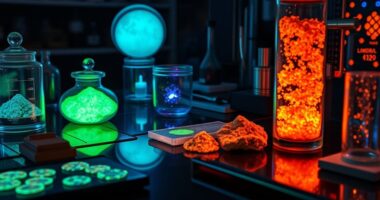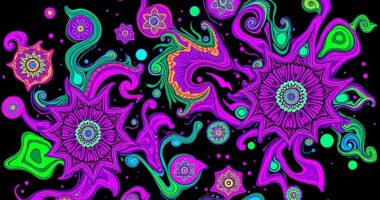Ukiyo-e prints showcase Japan’s mastery of woodblock techniques and vibrant color use, blending traditional craftsmanship with Western influences. You’ll notice how each print employs multiple carved blocks for precise color layers, creating vivid scenes of daily life. As techniques evolved, they incorporated Western pigments and perspectives, adding depth and realism. Exploring these prints reveals how Japanese artists pushed artistic boundaries while embracing new ideas, and if you look closer, you’ll uncover even more fascinating color stories.
Key Takeaways
- Ukiyo-e prints showcase innovative color layering through multi-block carving, enabling detailed and vibrant visual storytelling.
- The evolution of woodblock techniques expanded color palettes and allowed subtle shading, influencing the study of color expression.
- Western influences introduced new pigments and perspective methods, enriching the color complexity and realism in ukiyo-e.
- The integration of Western art ideas with traditional Japanese techniques advanced the understanding of color dynamics in prints.
- Ukiyo-e’s mastery of color contributed to its lasting artistic impact and helped shape Japan’s cultural approach to color study.

Ukiyo-e prints are iconic artworks that capture the fleeting beauty of everyday life in Japan during the Edo period. As you explore these prints, you’ll notice how masterful use of color brings scenes to life, reflecting the innovative techniques that artists employed. Central to this process are the Japanese woodblock techniques, which involve carving intricate designs into wood blocks for each color used. You might imagine the meticulous craftsmanship required to carve separate blocks for vibrant reds, blues, and yellows, aligning perfectly to produce seamless images. These techniques allowed artists to produce multiple impressions and experiment with color combinations, creating a rich visual experience. Over time, these methods evolved, enabling more subtle gradations and detailed shading, which added depth and dimension to their work. The evolution of printing methods also played a crucial role in expanding the possibilities of color expression in ukiyo-e. The influence of Western art also played a significant role in shaping the study of color within ukiyo-e. In the 19th century, Japan opened its doors to international trade, exposing ukiyo-e artists to Western painting techniques and color theories. You’ll see how this influence prompted a shift from traditional, limited palettes to more vibrant and varied hues. Western methods introduced new pigments and the use of perspective and shading, which artists incorporated into their woodblock prints. This blending of Japanese and Western approaches led to the development of more dynamic compositions and sophisticated color schemes. Artists like Hokusai and Hiroshige, for example, experimented with brighter colors and new techniques to depict landscapes and scenes with greater depth and realism.
Furthermore, the study of color in ukiyo-e reflects a broader cultural exchange. You might observe how Western ideas about light and shadow influenced Japanese printmaking, ushering in an era of innovation. The addition of Western pigments, such as synthetic ultramarine, expanded the color palette available to artists, allowing for more vibrant and durable prints. This cross-cultural exchange enhanced the aesthetic appeal of ukiyo-e and helped establish it as a highly influential art form. As you examine these prints, it’s clear that the mastery of Japanese woodblock techniques combined with Western artistic influences created a unique visual language. This synthesis of methods not only elevated the artistry but also deepened the understanding of color’s expressive potential, making ukiyo-e a timeless treasure in Japan’s cultural history.
Frequently Asked Questions
How Did Western Artists Influence Japanese Ukiyo-E Color Techniques?
Western influence introduced new ideas about color theory to Japanese artists, inspiring them to experiment with shading and tonal variations. You might notice how ukiyo-e artists adopted Western techniques to enhance depth and vibrancy in their prints. This cross-cultural exchange pushed Japanese artists to refine their color use, blending traditional methods with Western concepts, creating more dynamic and nuanced images that captivated viewers and expanded artistic possibilities.
What Role Did Natural Pigments Play in Ukiyo-E Print Longevity?
Think of natural pigments as the heartbeat of ukiyo-e prints, giving them life and vibrancy. You’ll find that these pigments, while beautiful, are prone to pigment aging and color fading over time. Their organic nature means they can break down, causing the prints’ colors to dull. Despite this, the use of natural pigments also guarantees a connection to nature, making each print a fleeting yet precious masterpiece that ages like a delicate flower.
How Did Technological Advances Impact Color Reproduction in Ukiyo-E?
Technological advances, like digital printing, revolutionized color reproduction in ukiyo-e by allowing more precise and consistent colors, enhancing the artwork’s vibrancy and accuracy. You can see how these innovations apply color theory principles, improving the way pigments blend and contrast. This progress made it easier to reproduce ukiyo-e prints with rich, detailed hues, preserving their visual impact and making them more accessible to wider audiences.
Were There Regional Differences in Color Preferences Across Japan?
You’ll notice regional differences in color preferences across Japan, contrasting urban and rural palettes. Urban areas favor vibrant, bold hues reflecting lively city life and status, while rural regions prefer softer, earthier tones tied to regional color symbolism and nature. These distinctions shaped ukiyo-e prints, illustrating local identities and cultural values, making each region’s artwork uniquely expressive of its environment and social influences.
How Did Collectors Authenticate the Original Colors of Ukiyo-E Prints?
You can authenticate the original colors of ukiyo-e prints by using chemical analysis to identify the pigments used, ensuring they match historical materials. Provenance verification also helps confirm authenticity by tracing the print’s ownership history. Combining these methods allows you to distinguish original colors from later restorations or reproductions, giving you confidence that the print’s colors are true to its original production.
Conclusion
You see how ukiyo-e prints reveal the vibrant world of Japan’s past, how they capture the beauty of everyday life, and how they explore the nuances of color. You recognize their role in shaping artistic traditions, their influence on modern art, and their ability to tell stories through vivid hues. You appreciate that these prints aren’t just images; they’re windows into a culture, a history, a mastery of color that continues to inspire you today.









